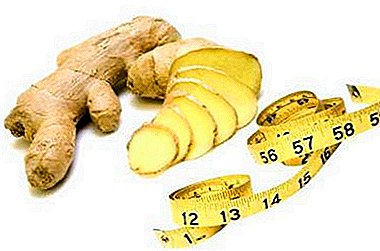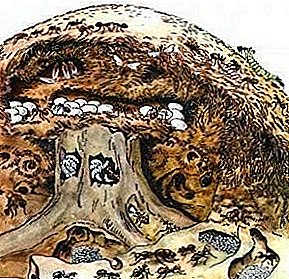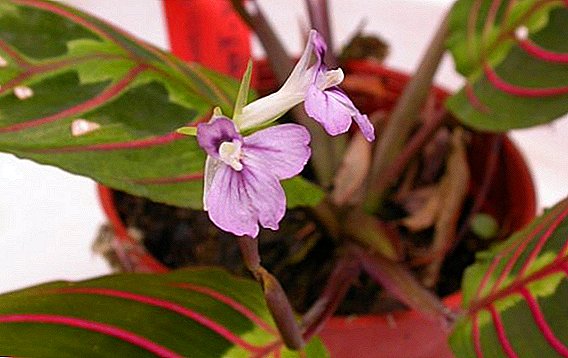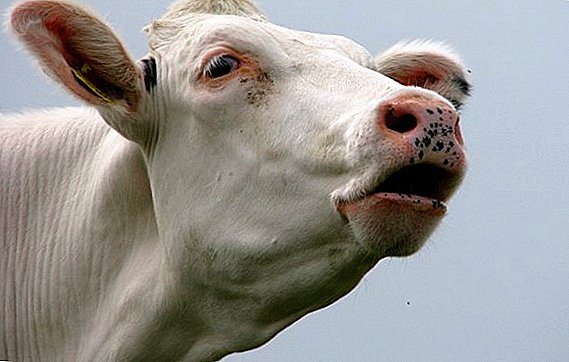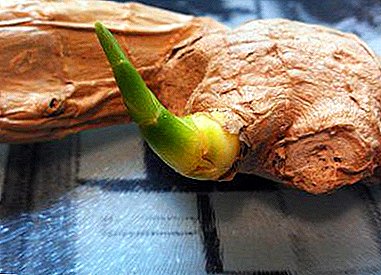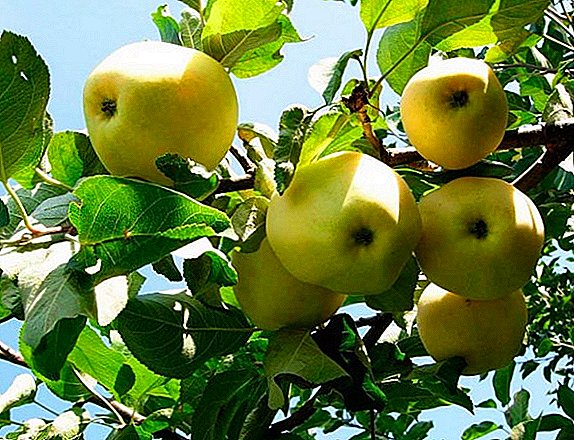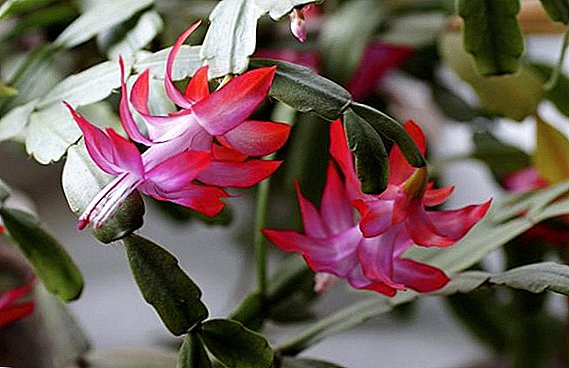 Schlumberger is known to most people as a zigokaktus, as well as a Christmas tree or Decembrist - and all because the peak of flowering of this unusual cactus falls on winter holidays.
Schlumberger is known to most people as a zigokaktus, as well as a Christmas tree or Decembrist - and all because the peak of flowering of this unusual cactus falls on winter holidays.
In this article we will discuss the topic of proper care for a flower, its reproduction and secrets of cultivation.
Botanical description of the plant
Originally from Brazil, where wild representatives of the genus grow on the branches of trees. The flower received its biological name in 1858 in honor of the French succulent collector Frederick Schlumberger. The Decembrist appeared on the windowsills of the inhabitants of Europe even earlier, in 1816, and after 74 years, Schlyumberger received an additional name - zygocactus, from the Greek word "zygon", which means "yoke".  Decembrist belongs to the genus of epiphytic cacti. The stems of the plant consist of flat shoots without thorns, divided into small segments with notches along the edges. The flowers are zygomorphic, that is, irregular, with one pronounced axis, have a tube and are located at the ends of the stems. The flowering period is in November - January.
Decembrist belongs to the genus of epiphytic cacti. The stems of the plant consist of flat shoots without thorns, divided into small segments with notches along the edges. The flowers are zygomorphic, that is, irregular, with one pronounced axis, have a tube and are located at the ends of the stems. The flowering period is in November - January.
The color of the flowers Schlyuberbergers - varied, from white to light purple. However, breeders to this day failed to bring blue and blue Decembrist.
Did you know? Schlumberger is referred to as long-lived flowers that continue their livelihoods for 20 years or more.
Types of Schlumbergers
There are about 10 types of Decembrist. The most common are 2 of them:
- Zigokaktus truncated, or truncate - Zygocactus truncatus. The shoots of this species have a light green color, grow to 40 cm and hang from the pot. At the ends grow buds, forming elongated multi-tiered flowers with petals bent back. The color range is varied.
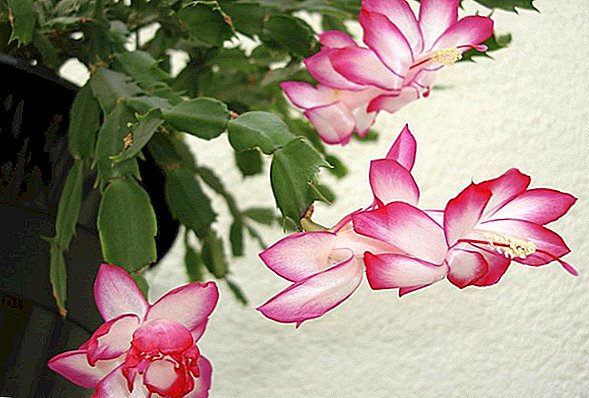
- Schlumbergera Buckley - Schlumbergera Bucklei. This is a larger view, the length of the shoots is up to 50 cm. The leaves are dark green. Flowers of different color, reach 8 cm in length, stacked, appear in the period from November to March.
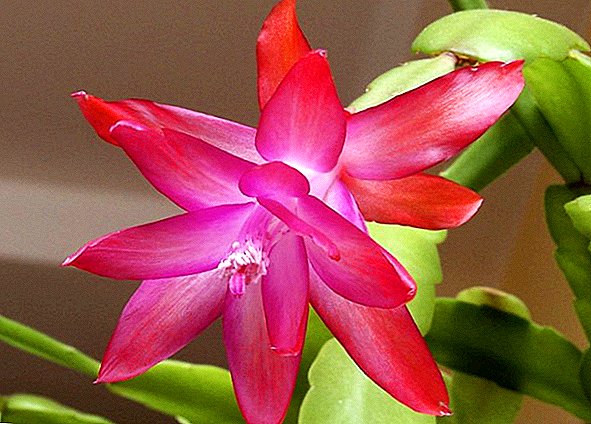
Plant varieties
In addition to Schlumberger species, there are also a large number of hybrid varieties. The most popular of them are:
- Lavender Doll. The flowers have a lavender color. Bush compact, with short segments.
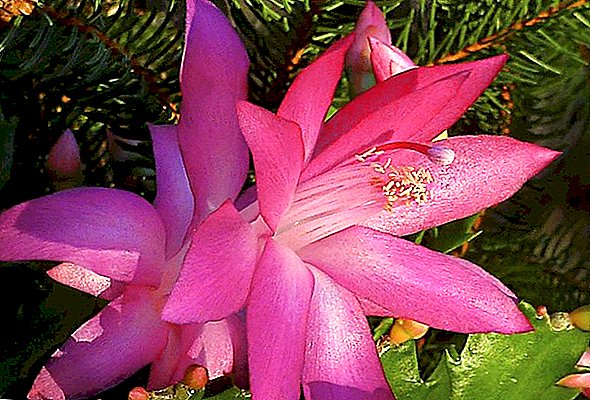
- Christmas fantasy. Bushy, with salmon flowers.
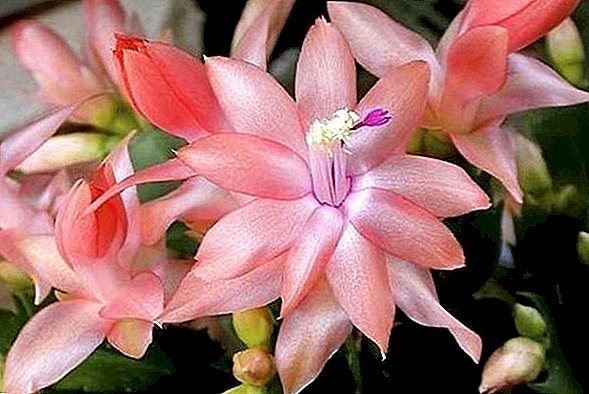
- Pasadena. Red Decembrist, different wide petals.
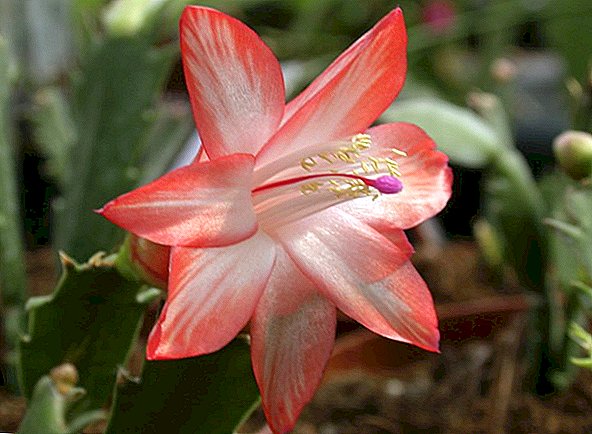
- Christmas Flame. Decembrist with yellow flowers, the color of which gradually turns into a pink hue.
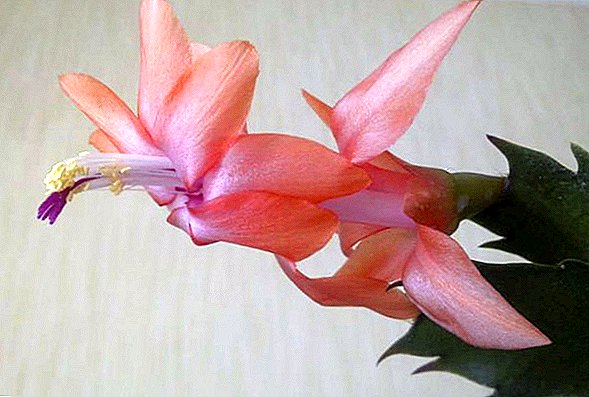
- White Christmas. White Decembrist blooms longer than other varieties.
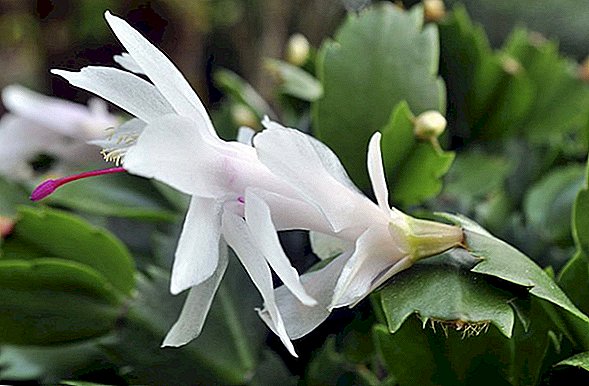
- Malissa. Decembrist with large white flowers with a pink pestle. Petals are rounded.
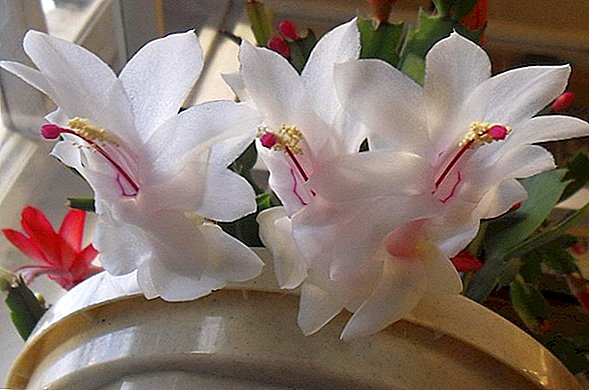
- Samba Brazil. The color of the buds is creamy, towards the ends of the petals smoothly turning into rich cherry. The flowers are large.

- Ara Brasil. Large bright red flowers with a bright center.
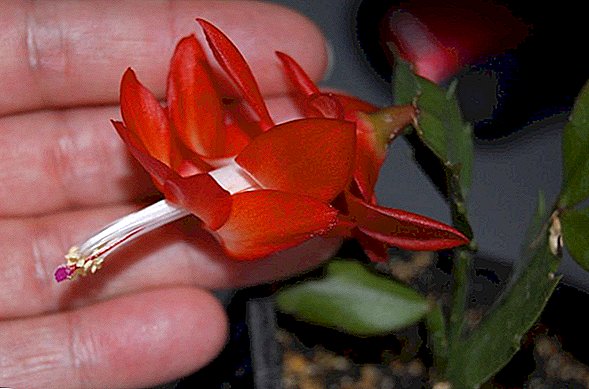
- Polka Dancer. The color is bright fuchsia, the petals are glossy, do not bend back.
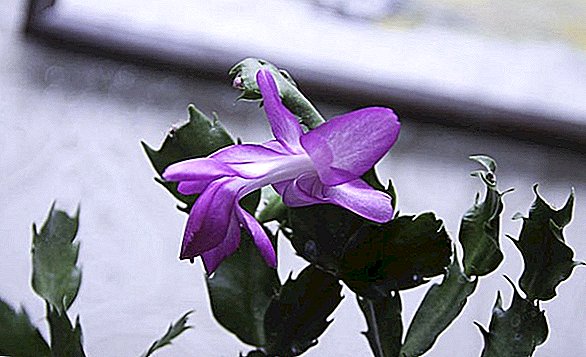
Conditions for growing at home
Like any other flower, zygocactus requires proper growing conditions, since this is the key to active growth, annual and long-term flowering.
Find out what to do if the Decembrist fades.
Location and lighting
Schlumberger does not belong to capricious plants. Have a pot with a Decembrist in the place where there is scattered abundant lighting. It is necessary to avoid direct sunlight, burning shoots. Ideal for flowerpots northeast window sills.
It is not recommended to place the plant near batteries or other heating devices. In the warm season, the Christmas tree can be moved to the open air in a shady place.
Temperature conditions
In spring and summer, any conditions will suit Schlyumberberger, the ideal temperature is + 20 ... + 25 ° С. But in the period of rest, falling in the middle of September - beginning of November, the plant should be moved to a cooler place with a temperature of up to + 16 ° С.  The beginning of budding entails the need for higher rates - at the level of + 30 ° С, which, after opening the buds, should be reduced to + 24 ... + 25 ° С.
The beginning of budding entails the need for higher rates - at the level of + 30 ° С, which, after opening the buds, should be reduced to + 24 ... + 25 ° С.
Important! During flowering, it is forbidden to carry and move the pot with zygocactus, as this will trigger the discharge of all buds.
Air humidity
Christmas tree loves spraying - it should be daily and be carried out with warm water. To maintain the required indicator of air humidity, you can put the pot in a tray filled with wet pebbles. Dry air can cause the flowers of the Decembrist to fall.
Home care
Having decided on the location and microclimate parameters for Schlumbergers, it is important to adhere to the agrotechnics as well. Properly chosen schemes for watering, transplanting and fertilizing are the best prevention of diseases and, as a result, a healthy and flowering plant.
Watering rules
When watering Decembrist can not be allowed complete drying of the earth. And at the same time, stagnation of water should be avoided, with the risk of rotting of the roots. Therefore, it is necessary to moisten the plant after drying the top layer of soil, about 1 time per week. During flowering, the number of waterings should be increased.  To humidify, one should take warm water of room temperature, approximately + 18 ... + 20 ° С. Zigokaktus does not like hard and chlorinated tap water, so you should prefer rain and melt water.
To humidify, one should take warm water of room temperature, approximately + 18 ... + 20 ° С. Zigokaktus does not like hard and chlorinated tap water, so you should prefer rain and melt water.
Top dressing
Fertilizers need to be made no more than 2-3 times a year., especially the Christmas tree needs to be made dressings during the growing season and flowering. For fertilizer, you should choose mixtures rich in nitrogen, potassium and phosphorus. In this case, universal fertilizers for cacti and flowering plants are well suited. The first procedure should be carried out in the warm period from March to August, the second - from November to January.
Pruning
Every year at the beginning of the summer, the shoots of Schömberberger need to be shortened - this will give the plant a neat shape and rejuvenate it. The shortened parts will begin to branch out, and the younger ones will produce more buds.
Important! For this procedure, it is undesirable to use cutting objects, as this may cause the shoots to rot. Therefore, it is better to unscrew the segments by hand.
Transfer
Replant the Decembrist as it grows: young plants - annually, adults - every 3 years. It is worth starting an event immediately after flowering, approximately in February-March. Capacity will be required shallow, but wide, since the rhizome is located in the upper soil layer.
The substrate is prepared from the following components:
- leaf earth;
- turf ground;
- coarse sand;
- peat.
All this should be mixed in a ratio of 2: 1: 1: 1, or purchase a special soil for cacti. To disinfect the mixture you need to make a small amount of charcoal. At the bottom of the tank must be placed drainage, which prevents stagnant moisture and suppuration of the roots. Next, the plant with a lump of earth should be moved to a new pot and covered with fresh soil, tamping it with your hands. At the end of the transplanted flower should be watered.
Video: Transplant Schlumberberts
Breeding
The most common method of reproduction of Schlyumbergers is grafting - due to its simplicity and convenience.
The technology of propagation by cuttings is:
- Unscrew the cutting from the plant manually - you can use the parts that remained after trimming the bush. It is important that the young escape consists of several segments.
- For a couple of days, cut the cuttings on the windowsill to dry the place of separation.
- The shoots put in clean water, or landed in a moist soil and cover with foil.
- After 3-4 weeks, the shoot should take root and root. The optimum temperature for this is + 15 ... + 20 ° С.
- Processes that have sprouted, transplanted into separate pots.

There is a more difficult way to reproduce zygocactus - by grafting:
- As a stock, it is better to use cacti such as prickly pears or perechiya prickly. On the stem of the selected plant, you must make a wedge-shaped incision.
- The end of the Decembrist is incised so as to make a point that can be inserted into the cut of the stock.
- Place vaccinations wrapped with paper tape or agro tape.
- The graft will grow in 2 weeks at a temperature of + 18 ... + 20 ° С.
- Having noticed the beginning of the growth of a graft shoot, remove the bandage.
Did you know? In an experiment on air purification in enclosed spaces, Schlumberberger was studied at NASA. It was found that the flower absorbs carbon dioxide well and releases oxygen at night.
Diseases and pests
Any modifications of the Christmas tree are talking about violations of the conditions of its cultivation and, as a result, about the deterioration of health. There are the following signs of ailments and parasitism:
- The graying and falling off of the segments suggests a fungal infection. For treatment, the flower should be treated with fungicides.
- Darkening and redness of the stem is caused by Ervina bacteria. You can save the plant, for this you need to remove the modified part.
- Yellow scurf on the shoots indicates the development of spider mites, against which the surface of the flower is to be treated with acaricides.

Difficulties in growing
Failure to care for the Decembrist also provokes modifications of the whole plant. The most common mistakes include:
- Reddening segments. This results in growing a flower in a cold environment.
- Flaccidity and shriveling. Irregularities in irrigation - this can be both a lack and an excess of moisture. In case of underfill, the soil is irrigated with warm water, and when casting, replanting is necessary, with preliminary removal of damaged roots.
- The fall of the buds. Often caused by stress: movement, lack of watering, drafts.
- Does not bloom. First of all, you should review the mode of irrigation, pritenit flower, or, conversely, move closer to the window. If the zigokaktus grows in close capacity, it is necessary to transplant it. But the most common cause is the absence of a rest period in a plant.
Find out what to do if Schlumbergera does not want to bloom.
Despite the bright and colorful flowering and thin flexible stems, Schrumberberger is quite unpretentious in the care. Therefore, it is worth to replenish your home greenhouse with this unusual cactus, follow all the above recommendations - and admire the large bright flowers throughout the winter.













